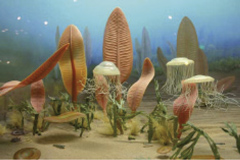
Campus Moncloa
Campus of International Excellence
Proterozoic
2500-541 M.a.

Landmasses consolidate and reach the size of real continents which collide with each other creating mountain ranges. As a result of plate tectonics the periods when continents are dispersed alternate with periods where they are grouped together to form a single continent. This is known as the supercontinent cycle and continues to happen today. The last two Proterozoic supercontinents are called Rodinia (formed about 1000 Ma ago) and Pannotia (about 600 Ma ago).

The first multicellular organisms appear at the end of the Proterozoic era (Ediacaran fauna).
Oxygen gradually accumulates in the atmosphere as a result of the photosynthetic activity of early life.
In this eon the first organisms with eukaryotic cells appear. They have a defined nucleus and organelles as a result of endosymbiosis with prokaryotic cells. Multicellular organisms appear almost at the end of this period in most of the major eukaryotic groups (fungi, plants, chromealveolates and animals).
| Hadean | ~4600-4000 M.a. |
| Archean | 4000-2500 M.a. |
| Proterozoic | 2500-541 M.a. |
| Cambrian | 541-485 M.a. |
| Ordovician | 485-443 M.a. |
| Silurian | 443-419 M.a. |
| Devonian | 419-359 M.a. |
| Carboniferous | 359-299 M.a. |
| Permian | 299-252 M.a. |
| Triassic | 252-201 M.a. |
| Jurassic | 201-145 M.a. |
| Cretaceous | 145-66 M.a. |
| Paleogene | 66-23 M.a. |
| Neogene | 23-2,6 M.a. |
| Quaternary | 2,6 M.a.-act. |
